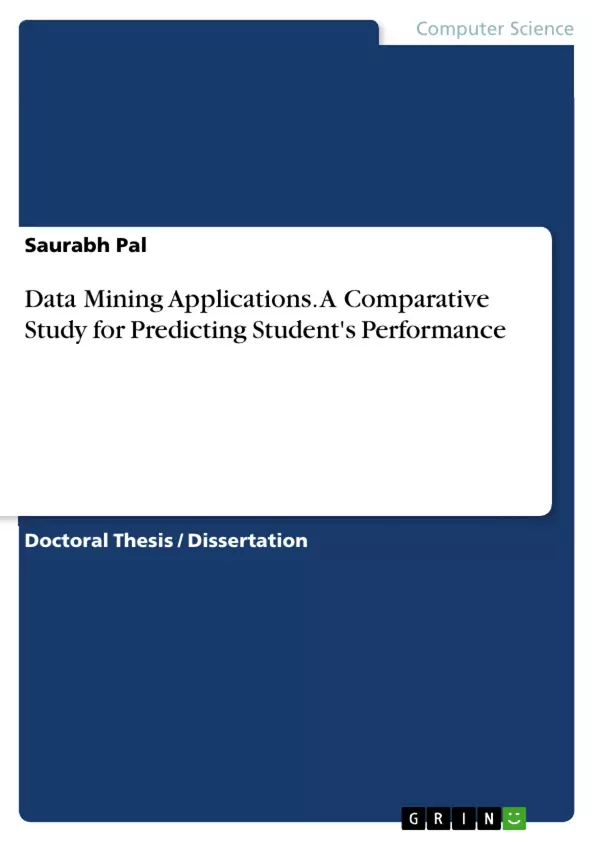The primary objective of this research is to develop a process to accurately predict useful data from the huge amount of available data using data mining techniques. Data Mining is the process of finding treads, patterns and correlations between fields in large RDBMS. It permits users to analyse and study data from multiple dimensions and approaches, classify it, and summarize identified data relationships. Our focus in this thesis is to use education data mining procedures to understand higher education system data better which can help in improving efficiency and effectiveness of education. In order to achieve a decisional database, many steps need to be taken which are explained in this thesis. This work investigates the efficiency, scalability, maintenance and interoperability of data mining techniques. In this research work, data-results obtained through different data mining techniques have been compiled and analysed using variety of business intelligence tools to predict useful data. An effort has also been made to identify ways to implement this useful data efficiently in daily decision process in the field of higher education in India.
Mining in educational environment is called Educational Data Mining. Han and Kamber describes data mining software that allow the users to analyze data from different dimensions, categorize it and Summarize the relationships which are identified during the mining process. New methods can be used to discover knowledge from educational databases. Every data has a lot of hidden information. The processing method of data decides what type of information data produce. In India education sector has a lot of data that can produce valuable information. This information can be used to increase the quality of education. But educational institution does not use any knowledge discovery process approach on these data. Information and communication technology puts its leg into the education sector to capture and compile low cost information. Now a day a new research community, educational data mining (EDM), is growing which is intersection of data mining and pedagogy. First chapter of the thesis elaborates the knowledge data discovery process, data mining concept, history and application of data mining in various industries.
Inhaltsverzeichnis (Table of Contents)
- Knowledge Data Discovery Process, Data Mining Concept, History and Application of Data Mining in Various Industries
- Roadmap of Research Done in Educational Data Mining in Various Segment of Education Sector
- Objective of Effective Advertisement Method to Attract Students in Institutions
- Objective of Predicting the Performance of Students
- Impact of Language on the Performance of Students in Class Room
- Objective of Measuring the Quality of a Teacher
Zielsetzung und Themenschwerpunkte (Objectives and Key Themes)
This thesis aims to develop a process for accurately predicting useful data from large datasets using data mining techniques. The focus is on applying educational data mining to understand and improve the efficiency and effectiveness of the higher education system in India. The research investigates the efficiency, scalability, maintenance, and interoperability of data mining techniques and explores how to implement useful data in daily decision-making processes within the education sector.
- Application of data mining techniques to predict useful data from large datasets
- Understanding and improving the higher education system in India
- Investigating the efficiency, scalability, maintenance, and interoperability of data mining techniques
- Exploring the implementation of useful data in daily decision-making processes within education
- Utilizing educational data mining to uncover hidden information and improve the quality of education
Zusammenfassung der Kapitel (Chapter Summaries)
- Chapter one provides an overview of the knowledge data discovery process, data mining concept, its history, and its application in various industries.
- Chapter two reviews existing research in educational data mining across different segments of the education sector, examining various tools and successful applications within the field.
- Chapter three investigates the objective of identifying effective advertising methods to attract students to educational institutions. It analyzes various methods such as newspaper ads, hoardings, pamphlets, radio, advertisement vans, and personal contact using support, confidence, and cosine analysis. The chapter concludes that hoardings and personal contact are more effective than other methods.
- Chapter four focuses on predicting student performance. The chapter utilizes data from previous years to develop a model that can help reduce dropout rates and improve institutional performance. Bayesian classification is employed for this purpose.
- Chapter five examines the impact of language on student performance in the classroom. Support, confidence, added value lift, correlation, and conviction analysis are used to evaluate the effectiveness of Hindi, English, and mixed-medium language instruction. The chapter concludes that mixed-medium classes have the highest level of interest.
- Chapter six aims to measure teacher quality and provide feedback on teacher strengths. A psychometric test is administered to collect student opinions on various teaching qualities, and a model is developed to analyze the results and identify adept teachers for specific tasks.
Schlüsselwörter (Keywords)
The key concepts and topics explored in this thesis include data mining, educational data mining, student performance prediction, advertising effectiveness, language impact on learning, teacher quality evaluation, higher education system in India, business intelligence tools, decision-making processes, knowledge discovery, and data analysis.
- Citation du texte
- Saurabh Pal (Auteur), 2014, Data Mining Applications. A Comparative Study for Predicting Student's Performance, Munich, GRIN Verlag, https://www.grin.com/document/378847



